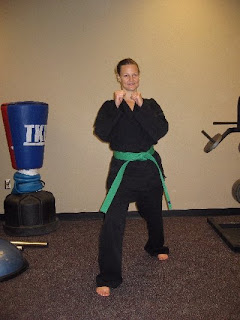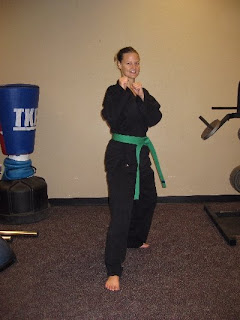This article was originally published in the September 1987 issue of Working Mother
magazine and was the seed for my January 2001 article in Taekwondo Times
magazine titled "No Point: The Case Against Competition in the Martial Arts." Please enjoy!
The Case Against Competition
By
Alfie KohnWhen it comes to competition, we Americans typically recognize only two legitimate positions: enthusiastic support and qualified support.
The first view holds that the more we immerse our children (and ourselves) in rivalry, the better. Competition builds character and produces excellence. The second stance admits that our society has gotten carried away with the need to be Number One, that we push our kids too hard and too fast to become winners -- but insists that competition can be healthy and fun if we keep it in perspective.
I used to be in the second camp. But after five years of investigating the topic, looking at research from psychology, sociology, education and other fields. I'm now convinced that neither position is correct. Competition is bad news all right, but it's not just that we overdo it or misapply it. The trouble lies with competition itself. The best amount of competition for our children is none at all, and the very phrase "healthy competition" is actually a contradiction in terms.
That may sound extreme if not downright un-American. But some things aren't just bad because they're done to excess; some things are inherently destructive. Competition, which simply means that one person can succeed only if others fail, is one of those things. It's always unnecessary and inappropriate at school, at play and at home.
Think for a moment about the goals you have for your children. Chances are you want them to develop healthy self-esteem, to accept themselves as basically good people. You want them to become successful, to achieve the excellence of which they're capable. You want them to have loving and supportive relationships. And you want them to enjoy themselves.
These are fine goals. But competition not only isn't necessary for reaching them -- it actually undermines them.
Competition is to self-esteem as sugar is to teeth. Most people lose in most competitive encounters, and it's obvious why that causes self-doubt. But even winning doesn't build character; it just lets a child gloat temporarily. Studies have shown that feelings of self-worth become dependent on external sources of evaluation as a result of competition: Your value is defined by what you've done. Worse -- you're a good person in proportion to the number of people you've beaten.
In a competitive culture, a child is told that it isn't enough to be good -- he must triumph over others. Success comes to be defined as victory, even though these are really two very different things. Even when the child manages to win, the whole affair, psychologically speaking, becomes a vicious circle: The more he competes, the more he needs to compete to feel good about himself.
When I made this point on the Phil Donahue Show, my objections were waved aside by the parents of a seven-year-old tennis champion named Kyle, who appeared on the program with me. Kyle had been used to winning ever since a tennis racket was put in his hands at the age of two. But at the very end of the show, someone in the audience asked him how he felt when he lost. Kyle lowered his head and in a small voice replied, "Ashamed."
This is not to say that children shouldn't learn discipline and tenacity, that they shouldn't be encouraged to succeed or even have a nodding acquaintance with failure. But none of these requires winning and losing -- that is, having to beat other children and worry about being beaten. When classrooms and playing fields are based on cooperation rather than competition, children feel better about themselves. They work with others instead of against them, and their self-esteem doesn't depend on winning a spelling bee or a Little League game.
Children succeed in spite of competition, not because of it. Most of us were raised to believe that we do our best work when we're in a race -- that without competition we would all become fat, lazy and mediocre. It's a belief that our society takes on faith. It's also false.
There is good evidence that productivity in the workplace suffers as a result of competition. The research is even more compelling in classroom settings. David Johnson, a professor of social psychology at the University of Minnesota, and his colleagues reviewed all the studies they could find on the subject from 1924 to 1980. Sixty-five of the studies found that children learn better when they work cooperatively as opposed to competitively, eight found the reverse, and 36 found no significant difference. The more complex the learning task, the worse children in a competitive environment fared.
Brandeis University psychologist Teresa Amabile was more interested in creativity. She asked 22 girls, ages seven to 11, to make "silly collages." Some competed for prizes and some didn't. Seven artists then independently rated the girls' work. It turned out that the children who were trying to win produced collages that were much less creative -- less spontaneous, complex and varied -- than the others.
One after another, researchers across the country have concluded that children do not learn better when education is transformed into a competitive struggle. Why? First, competition often makes kids anxious and that interferes with concentration. Second, competition doesn't permit them to share their talents and resources as cooperation does, so they can't learn from one another. Finally, trying to be Number One distracts them from what they're supposed to be learning. It may seem paradoxical, but when a student concentrates on the reward (an A or a gold star or a trophy), she becomes less interested in what she's doing. The result: Performance declines.
Just because forcing children to try to outdo one another is counterproductive doesn't mean they can't keep track of how they're doing. There's no problem with comparing their achievements to an objective standard (how fast they ran, how many questions they got right) or to how they did yesterday or last year. But any mother who values intellectual development for her child should realize that turning learning into a race simply doesn't work.
Competition is a recipe for hostility. By definition, not everyone can win a contest. If one child wins, another cannot. This means that each child inevitably comes to regard others as obstacles to his or her own success. Forget fractions or home runs; this is the real lesson our children learn in a competitive environment.
Competition leads children to envy winners, to dismiss losers (there's no nastier epithet in our language than "Loser!") and to be suspicious of just about everyone. Competition makes it difficult to regard others as potential friends or collaborators; even if you're not my rival today, you could be tomorrow.
This is not to say that competitors will always detest each other. But trying to outdo someone is not conducive to trust -- indeed, it would be irrational to trust someone who gains from your failure. At best, competition leads one to look at others through narrowed eyes; at worst, it invites outright aggression. Existing relationships are strained to the breaking point, while new friendships are often nipped in the bud.
Again, the research helps to explain the destructive effect of win/lose arrangements. When children compete, they are less able to take the perspective of others -- that is, to see the world from someone else's point of view. One study demonstrated conclusively that competitive children were less empathetic than others; another study showed that competitive children were less generous.
Cooperation, on the other hand, is marvelously successful at helping children to communicate effectively, to trust in others and to accept those who are different from themselves. Competition interferes with these goals and often results in outright antisocial behavior. The choice is ours: We can blame the individual children who cheat, turn violent or withdraw, or we can face the fact that competition itself is responsible for such ugliness.
Studies also show, incidentally, that competition among groups isn't any better than competition among individuals. Kids don't have to work against a common enemy in order to know the joys of camaraderie or to experience success. Real cooperation doesn't require triumphing over another group.
Having fun doesn't mean turning playing fields into battlefields. It's remarkable, when you top to think about it, that the way we teach our kids to have a good time is to play highly structured games in which one individual or team must defeat another.
Consider one of the first games our children learn to play: musical chairs. Take away one chair and one child in each round until one smug winner is seated and everyone else has been excluded from play. You know that sour birthday party scene; the needle is lifted from the record and someone else is transformed into a loser, forced to sit out the rest of the game with the other unhappy kids on the side. That's how children learn to have fun in America.
Terry Orlick, a Canadian expert on games, suggests changing the goal of musical chairs so children are asked to fit on a diminishing number of seats. At the end, seven or eight giggling, happy kids are trying to squish on a single chair. Everyone has fun and there are no winners or losers.
What's true of musical chairs is true of all recreation; with a little ingenuity, we can devise games in which the obstacle is something intrinsic to the task itself rather than another person or team.
In fact, not one of the benefits attributed to sports or other competitive games actually requires competition. Children can get plenty of exercise without struggling against each other. Teamwork? Cooperative games allow everyone to work together, without creating enemies. Improving skills and setting challenges? Again, an objective standard or one's own earlier performance will do.
When Orlick taught a group of children noncompetitive games, two thirds of the boys and all of the girls preferred them to games that require opponents. If our culture's idea of a good time is competition, it may just be because we haven't tried the alternative.
How can parents raise a noncompetitive child in a competitive world? Competition is actually destructive to children's self-esteem. It interferes with learning, sabotages relationships and isn't necessary for a good time. But how do you raise a child in a culture that hasn't yet caught on to this?
There are no easy answers here. But there is one clearly unsatisfactory answer: Make your son or daughter competitive in order to fit into the "real world." That isn't desirable for the child -- for all the reasons given here -- and it perpetuates the poison of competition in another generation.
Children can be taught about competition, prepared for the destructive forces they'll encounter, without being groomed to take part in it uncritically. They can be exposed to the case against competition just as they are taught the harms of drug abuse or reckless driving.
You will have to decide how much compromise is appropriate so your child isn't left out or ridiculed in a competitive society. But at least you can make your decision based on knowledge about competition's destructiveness. You can work with other parents and with your child's teachers and coaches to help change the structures that set children against one another. Of you may want to look into cooperative schools and summer camps, which are beginning to catch on around the country.
As for reducing rivalry and competitive attitudes in the home:
* Avoid comparing a child's performance to that of a sibling, a classmate, or yourself as a child.
* Don't use contests ("Who can dry the dishes fastest?") around the house. Watch your use of language ("Who's the best little girl in the whole wide world?") that reinforces competitive attitudes.
* Never make your love or acceptance conditional on a child's performance. Some parents give subtle messages; they may say to their child, "As long as you did your best..." but Bobby knows that Mommy really likes him better when he wins. Nothing is more psychologically destructive than making approval dependent on victory.
* Be aware of your power as a model. If you need to beat others, your child will learn that from you regardless of what you say. The lesson will be even stronger if you use your child to provide you with vicarious victories.
Raising healthy, happy, productive children goes hand in hand with creating a better society. The first step to achieving both is recognizing that our belief in the value of competition is built on myths. There are better ways for our children -- and for us -- to work and play and live.

























